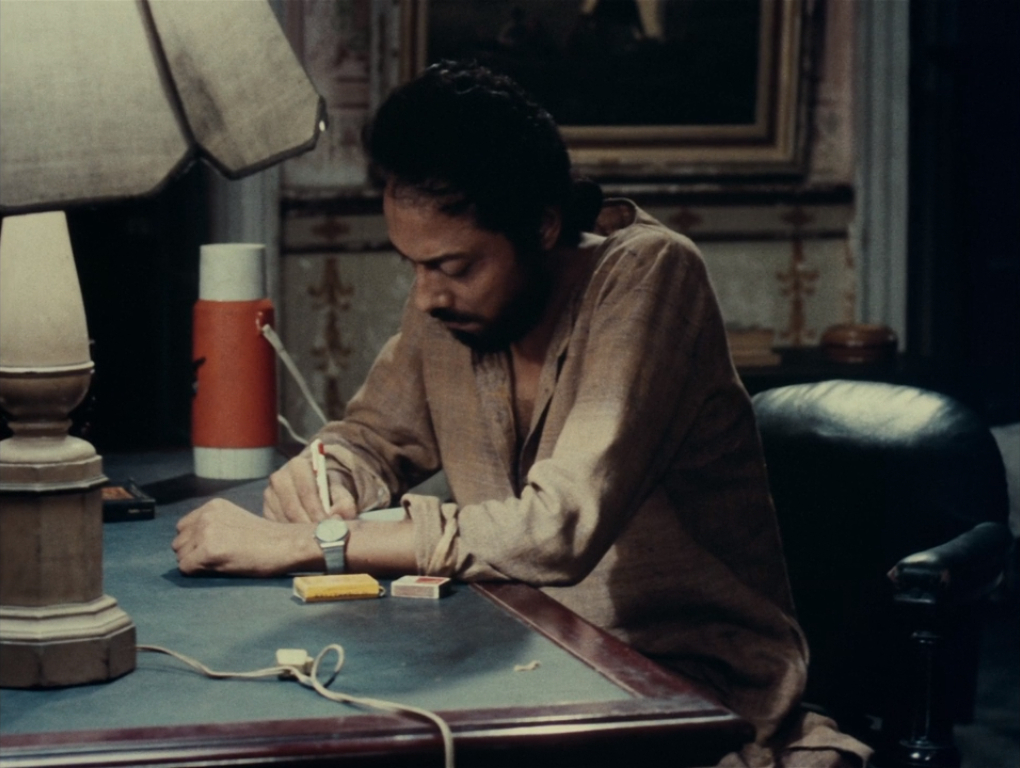
Antareen
1993, directed by Mrinal Sen
The characters in Antareen frequently allude to Rabindranath Tagore’s Hungry Stones, and the movie comes across as a less fantastical version of the short story. Instead of being set in the marble palace of a Mughal emperor high on a remote hill, it’s set in a crumbling colonial mansion in the heart of Kolkata. Instead of the lonely guest communicating with the long-dead spirit of an Arab concubine, he has six telephone conversations with a neglected housewife who dials him out of the blue from her high-rise apartment. Still there’s something uncanny about the woman he speaks with. She first calls just when he has picked up a pen and started writing. Is she real, or is she a fantasy conjured by his writerly imagination?
But that’s not exactly correct. It’s not the act of writing that immediately coincides with her initial call. The phone first rings when he pauses his diary to pour himself tea from a thermos. To his surprise the thermos is empty, and her two calls that night also turn up “empty”. She does not speak to him until the following day, and it so happens that this too is precipitated by tea – he has begun preparing it when the phone rings, he interrupts to remove the kettle from the stove and brew the leaves, and when he gets up again to pour a glass (which he finds too bitter) she hangs up on him. So far their first one-way contact and their first conversation are both sparked by tea, so it’s not altogether surprising that their only physical meeting, at the end of the movie, happens when he leans out of a train door to order tea. The tea never comes, and she doesn’t speak to him, although she clearly recognizes his voice.
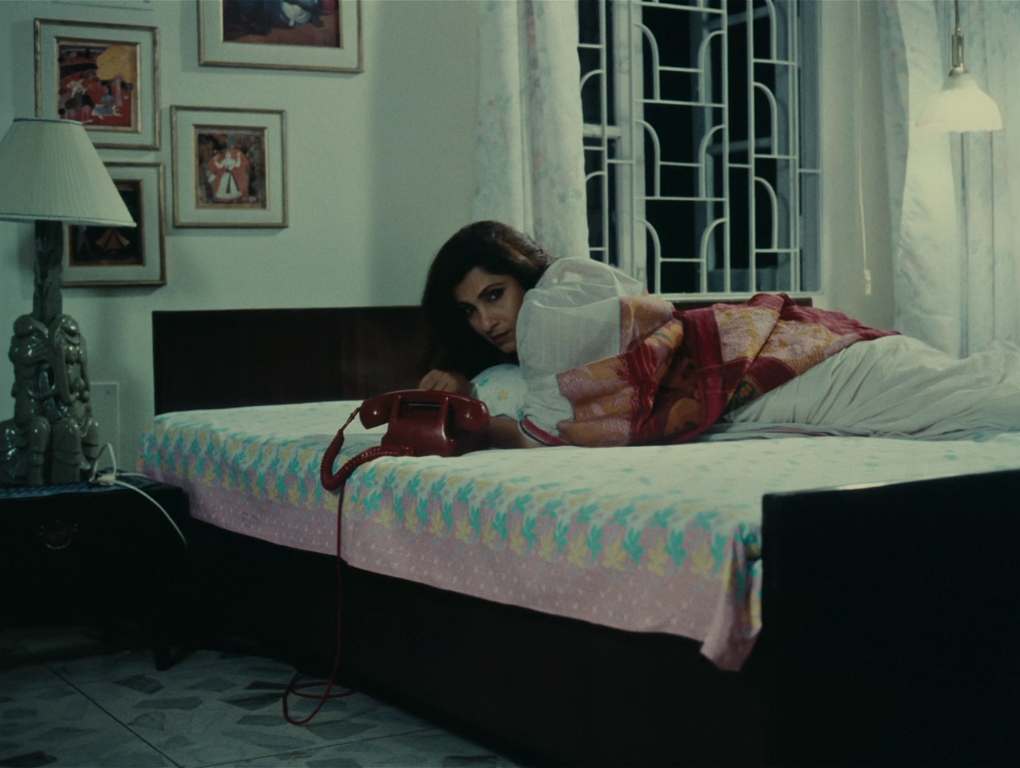
Mrinal Sen is no stranger to the subtle magic of incidental objects, the same kind of magic Hitchcock weaves with a ring, for example, in Shadow of a Doubt. In at least a couple of Sen’s earlier films, Padatik and Ek Din Achanak, the bewitched object is the telephone, which is always sinister, threatening, or disruptive, bringing bad news or unfortunate conversations. It would seem that Sen views telephones with suspicion. In Antareen however the phone is an instrument of romance, and it reunites the woman with her family, apparently freeing her from captivity in a bad marriage. But it’s doubtful whether the writer is equally fortunate. By the end it looks like he’s traded places with her, ensnared in an unhappy fantasy like the narrator of Hungry Stones who becomes the latest in a line of guests trapped or driven mad by the concubine’s ghost.
The Bengali title Antareen translates to “interned” or “confined”. The one time the word “confined” occurs in the dialogue, after the third phone call as the writer ponders Hungry Stones in connection to his telephone romance, the movie cuts to the iron bars of an elevator gate slamming shut. The elevator rises several floors behind iron gates, then the scene cuts to a fish tank in the woman’s apartment – another image of confinement. The same sequence of the elevator gates and fish tank follows the woman’s unhappy phone call with her husband at the moment when she feels most confined. The comparison between her and the eternally confined concubine of Hungry Stones is abundantly clear.
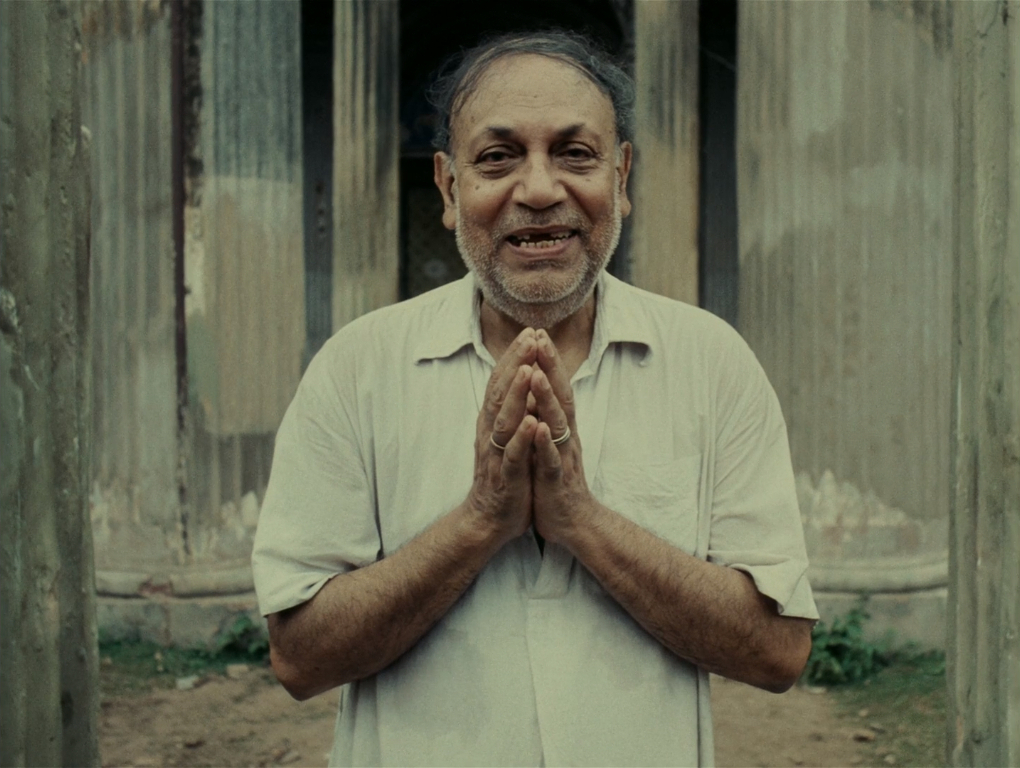
As the writer finds himself drawn ever deeper into this virtual relationship, the movie links the two leads through numerous parallels. Both are waited upon by an old servant. She wakes up from a nightmare of a woman screaming for help from a speeding car, then he awakes after an ambulance speeds down a highway. Her bedside clock stops before the third phone call, and his bedroom clock stops at the end of his stay. His telephone is olive green and hers is red, but toward the end he wears red while she wears olive green. At the end she appears to have freed herself from an oppressive husband, but now he looks like the one who’s confined, sitting behind the iron bars of a train window imprisoned in a romantic fantasy.
Once we notice that allusions to tea precede each major step of the writer’s descent into romantic hopelessness, we can begin to expand the hidden role of tea throughout Antareen. The servant Banamali mentions it first, relaying his master’s words: “He also said you live practically on tea, just tea.” After the bitter tea at the end of the first phone conversation, there is no tea until Banamali returns with his grandson and serves tea to the writer. This glass immediately precedes the dead call between the third and fourth phone conversations, when the writer yells at the silent phone. Observing his own frustrated desire, it’s here he begins to realize he’s falling for the woman. He spends the next three days near the phone waiting for her. The next glass of tea leads to the nighttime thunderstorm, which arouses Nabakanto to awaken the writer, who rushes to the phone thinking he’s missed a call. Once again his unthinking response reveals to him how deeply entangled he is in his desire.
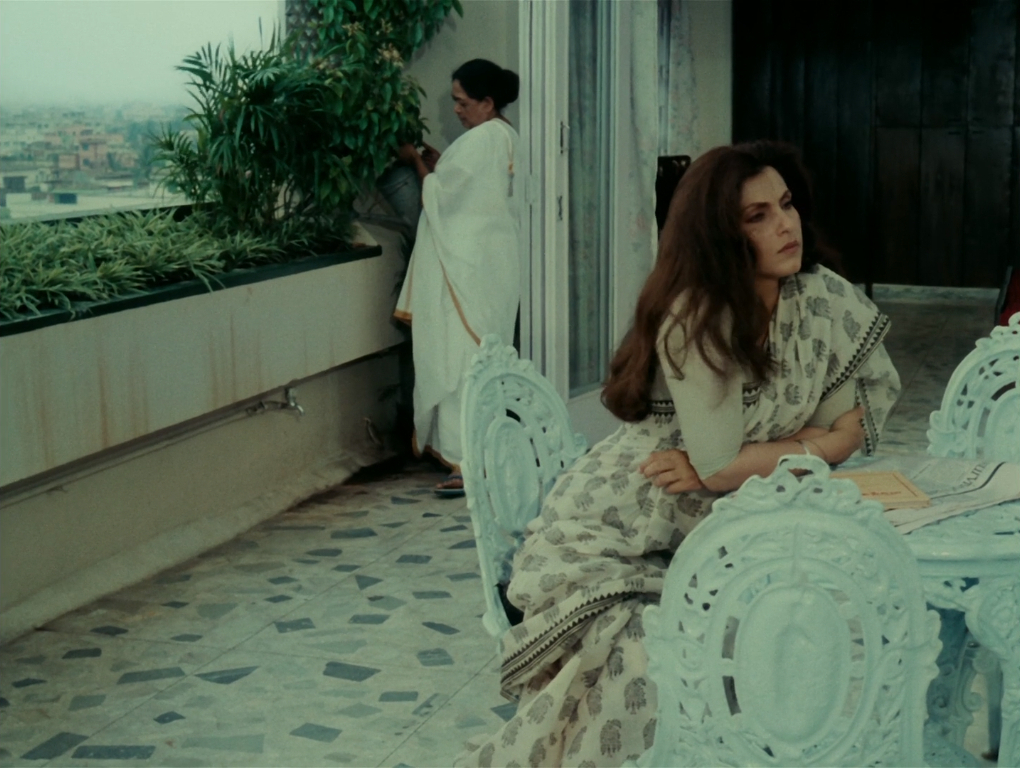
So far we may have noticed that it matters whether the tea is consumed or not, and even whether or not it’s enjoyed. The empty thermos led to two vacant phone calls, and the bitter tea coincided with the annoyance of the woman hanging up. Next we come to a scene which should have been ripe for the cutting room floor were it not for the film’s secret language of tea. Right before the woman visits her family (at the writer’s encouragement), her servant washes out a tea kettle in the kitchen. If tea always signals confinement, this finished kettle signifies the end of the woman’s exile from her family in her joyless marriage. Likewise, the writer’s last cup of tea is served as he’s packing to leave. He reaches for it and hesitates, and we never see whether he drinks it or not. At this point he nostalgically turns on the hallway light, as if remembering the thrill of his phone calls, and just before we see him on the train the woman’s phone rings nine times. Is the writer making one last attempt at contact? Not knowing whether he drank his tea makes the ending ambiguous.
Expressing confinement through tea brings the movie tantalizingly close to India’s colonization under the British Empire and the East India Company, when the country fed England’s insatiable appetite for tea. Insofar as Antareen is a modern retelling of Hungry Stones, the British have replaced the Mughals in India’s memory of colonizers, as the decaying Victorian palace replaces the short story’s marble palace. The movie mentions England only once, when Banamali opens the queen mother’s locked chamber, saying “She fought legal battles with the English, all alone.” Banamali speaks of the room reverently, and it’s the first time we see the writer’s face. This old sanctum makes one more ghostly appearance when its double doors open by themselves as the writer reads Hungry Stones in bed.
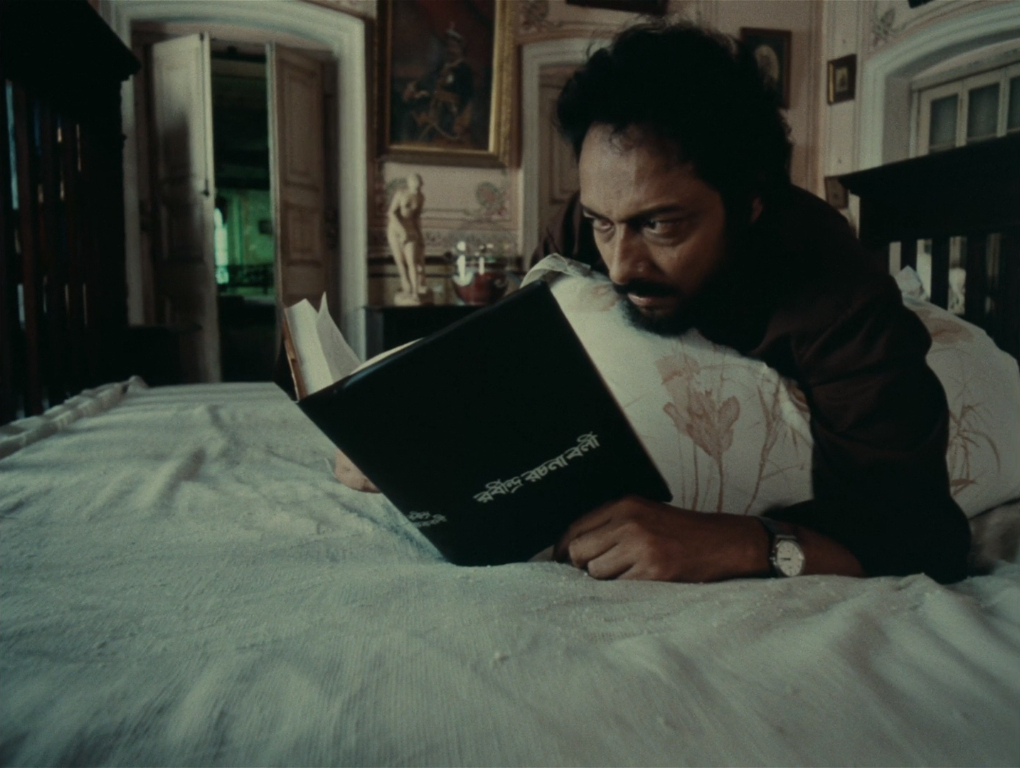
Antareen may be indirect in summoning India’s colonial past, but the signs are always present – the old mansion, the characters entrapped in various modes of confinement. The final scene shows the common people of India sitting in a train carriage, all separated from their verdant land by iron bars, as if a sense of confinement is a universal condition in a country released from a long enslavement to a foreign empire.
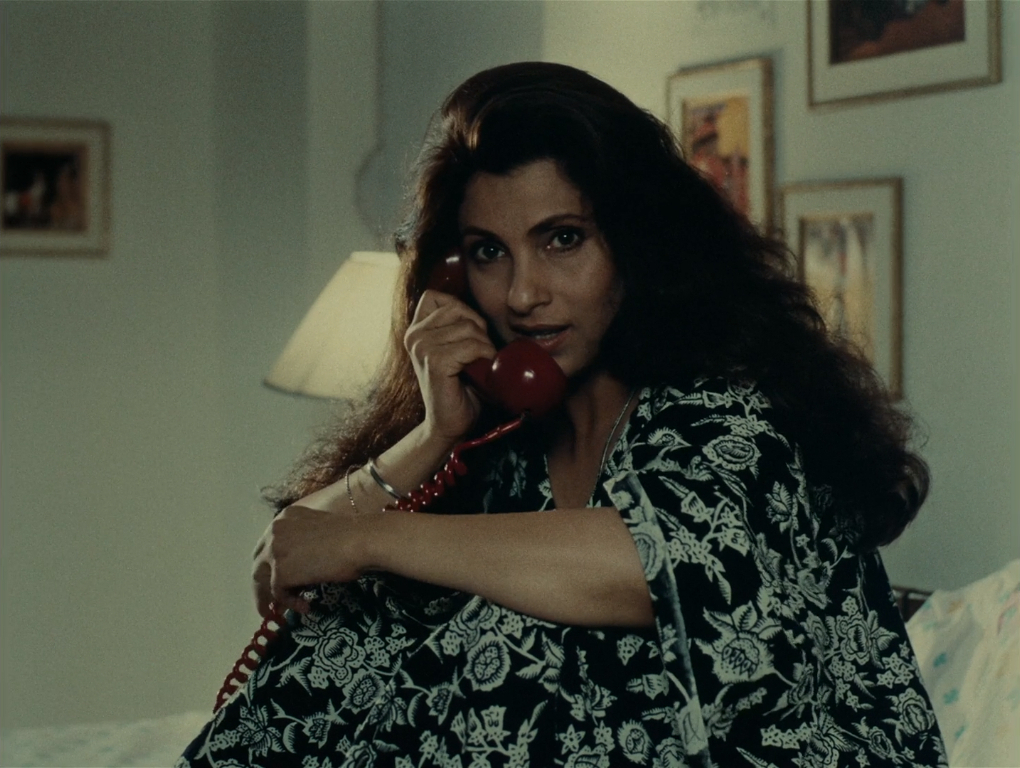
The ending, however, is not absolute; the movie is as open-ended as Tagore’s Hungry Stones. The writer’s stay in his friend’s palace is bracketed by nearly identical shots of railroad tracks speeding across the screen, and the closing view from the train window is likewise strongly horizontal. In classical film construction it’s normal to open with some kind of horizontal motion, implying linear time and narrative movement, but the ending should be a form of eternal time and narrative resolution. By closing with a horizontal motion that so strongly echoes the opening, Antareen situates the story in the flow of history, denying any kind of resolution. The film is inserted squarely in the present, leaving the future wide open. India may yet escape the confinement of its colonial mindset, possibly very soon, just as the woman escapes so readily from her oppressive husband. The writer’s future is also wide open; we don’t know whether he guessed the woman’s identity upon meeting her, nor do we know what effect their meeting may have on him. As he sits by the window lost in thought, a thermos hangs on the hook beside him. We can surmise that the thermos is empty, though we cannot be quite sure. Like the woman whose phone calls stirred his longing, and who leaves an empty vessel of tea behind her on her way to freedom, he too has hope of escaping from confinement.
CONNECTIONS:
Shadow of a Doubt – Symbolic power invested in an ordinary object; ambiguity of gloves at end / ambiguity of last glass and thermos
Black Narcissus – Characterization of Britain’s colonization of India
The Music Room – Victorian-era mansion characterizing the faded glory of Indian aristocracy from the Raj
Les bonnes femmes – Story of confinement
Bhuvan Shome – Satyajit Ray allusion: woman on swing (Charulata), vermin on painting (Jalsaghar)
Padatik – Telephone as a consistently sinister object
Ek Din Achanak – Telephone as a consistently sinister object
LIST OF PHONE CALLS:
0:09:32 – empty call (precipitated by empty tea thermos)
0:10:28 – empty call
0:12:08 – 0:16:49 – 1st call (precipitated by making tea)
0:17:51 – 0:24:19 – 2nd call (precipitated by paper blowing in wind, sound of airplane)
0:29:21 – 0:34:42 – 3rd call (precipitated by double nightmare)
0:42:26 – 0:43:47 – empty call (precipitated by tea service; Naba is watching)
0:46:37 – 0:52:06 – 4th call (precipitated by lines about waiting for 3 days)
0:56:15 – false alarm (Nabakanto wakes writer up during thunderstorm, writer goes directly to phone)
0:56:59 – 0:58:24 – woman’s husband calls for her, servant answers
0:59:29 – 1:00:16 – 5th call (precipitated by servant scolding woman in rainstorm)
1:02:09 – writer picks up phone, doesn’t make call (precipitated by reading Hungry Stones at desk)
1:03:41 – 1:05:09 – woman receives call from her husband
1:13:41 – 1:18:11 – 6th call (precipitated by writer going to the phone to call woman)
1:22:15 – 1:22:37 – empty call to woman’s apartment, rings 9x (precipitated by flipping light switch)